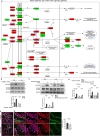Rudhira-mediated microtubule stability controls TGFβ signaling during mouse vascular development
- PMID: 40372775
- PMCID: PMC12080998
- DOI: 10.7554/eLife.98257
Rudhira-mediated microtubule stability controls TGFβ signaling during mouse vascular development
Abstract
The transforming growth factor β (TGFβ) signaling pathway is critical for survival, proliferation, and cell migration, and is tightly regulated during cardiovascular development. Smads, key effectors of TGFβ signaling, are sequestered by microtubules (MTs) and need to be released for pathway function. Independently, TGFβ signaling also stabilizes MTs. Molecular details and the in vivo relevance of this cross-regulation remain unclear, understanding which is important in complex biological processes such as cardiovascular development. Here, we use rudhira/Breast Carcinoma Amplified Sequence 3 (Bcas3), an MT-associated, endothelium-restricted, and developmentally essential proto-oncogene, as a pivot to decipher cellular mechanisms in bridging TGFβ signaling and MT stability. We show that Rudhira regulates TGFβ signaling in vivo, during mouse cardiovascular development, and in endothelial cells in culture. Rudhira associates with MTs and is essential for the activation and release of Smad2/3 from MTs. Consequently, Rudhira depletion attenuates Smad2/3-dependent TGFβ signaling, thereby impairing cell migration. Interestingly, Rudhira is also a transcriptional target of Smad2/3-dependent TGFβ signaling essential for TGFβ-induced MT stability. Our study identifies an immediate early physical role and a slower, transcription-dependent role for Rudhira in cytoskeleton-TGFβ signaling crosstalk. These two phases of control could facilitate temporally and spatially restricted targeting of the cytoskeleton and/or TGFβ signaling in vascular development and disease.
Keywords: BCAS3; Rudhira; Smad2/3; TGFβ signaling; cell biology; developmental biology; microtubule cytoskeleton; mouse.
© 2024, Joshi, Jindal et al.
Conflict of interest statement
DJ, PJ, RS No competing interests declared, MI Reviewing editor, eLife
Figures









Update of
- doi: 10.1101/2024.04.23.590724
- doi: 10.7554/eLife.98257.1
- doi: 10.7554/eLife.98257.2
- doi: 10.7554/eLife.98257.3
Similar articles
-
Rudhira/BCAS3 couples microtubules and intermediate filaments to promote cell migration for angiogenic remodeling.Mol Biol Cell. 2019 Jun 1;30(12):1437-1450. doi: 10.1091/mbc.E18-08-0484. Epub 2019 Apr 17. Mol Biol Cell. 2019. PMID: 30995157 Free PMC article.
-
Rudhira/BCAS3 is essential for mouse development and cardiovascular patterning.Sci Rep. 2018 Apr 4;8(1):5632. doi: 10.1038/s41598-018-24014-w. Sci Rep. 2018. PMID: 29618843 Free PMC article.
-
Rudhira/BCAS3 is a cytoskeletal protein that controls Cdc42 activation and directional cell migration during angiogenesis.Exp Cell Res. 2012 Apr 1;318(6):753-67. doi: 10.1016/j.yexcr.2012.01.016. Epub 2012 Jan 25. Exp Cell Res. 2012. PMID: 22300583
-
New tricks for an old fox: impact of TGFβ on the DNA damage response and genomic stability.Sci Signal. 2014 Sep 2;7(341):re5. doi: 10.1126/scisignal.2005474. Sci Signal. 2014. PMID: 25185158 Review.
-
It Takes Two to Tango: Endothelial TGFβ/BMP Signaling Crosstalk with Mechanobiology.Cells. 2020 Aug 26;9(9):1965. doi: 10.3390/cells9091965. Cells. 2020. PMID: 32858894 Free PMC article. Review.
References
-
- Bärlund M, Monni O, Weaver JD, Kauraniemi P, Sauter G, Heiskanen M, Kallioniemi O-P, Kallioniemi A. Cloning of BCAS3 (17q23) and BCAS4 (20q13) genes that undergo amplification, overexpression, and fusion in breast cancer. Genes, Chromosomes & Cancer. 2002;35:311–317. doi: 10.1002/gcc.10121. - DOI - PubMed
MeSH terms
Substances
Grants and funding
LinkOut - more resources
Full Text Sources

